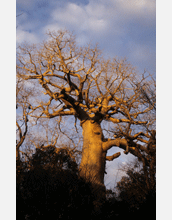Multimedia Gallery
Projected Habitat Loss and Climate Change (Image 3)
Projected Habitat Loss and Climate Change (Image 3)
A Baobab Tree in Madagascar, one of the areas where projected habitat loss and climate change are expected to drive the need for future reserves to prevent biodiversity loss.
A research study, funded by the National Science Foundation and headed by Walter Jetz, assistant professor of biological sciences at the University of California, San Diego, found that many of the regions that face the greatest habitat change, in relation to the amount of land currently protected--like Indonesia and Madagascar--are in globally threatened and endemic species-rich, developing tropical nations that have the fewest resources for conservation. On the other hand, many of the temperate regions of the planet that already have an expansive network of reserves are in countries like Austria, Germany and Switzerland, with the greatest financial resources for conservation efforts, but comparatively less biodiversity under threat.
Jetz and his research team created a series of global maps that reflect these findings and are intended to provide a guide for conservationists to the areas of our planet where conservation investments would have the most impact in the future, thus limiting extinctions and damage to ecosystems caused by rapid, human-driven climate change and poor land-use. To learn more, see the UC-San Diego news release, "Study Finds Future 'Battlegrounds' for Conservation Very Different to Those in Past." (Date of Image: 2007) [Image 3 of 3 related images. Back to Image 1.]
Credit: Walter Jetz, UCSD
Images and other media in the National Science Foundation Multimedia Gallery are available for use in print and electronic material by NSF employees, members of the media, university staff, teachers and the general public. All media in the gallery are intended for personal, educational and nonprofit/non-commercial use only.
Images credited to the National Science Foundation, a federal agency, are in the public domain. The images were created by employees of the United States Government as part of their official duties or prepared by contractors as "works for hire" for NSF. You may freely use NSF-credited images and, at your discretion, credit NSF with a "Courtesy: National Science Foundation" notation.
Additional information about general usage can be found in Conditions.
Also Available:
Download the high-resolution JPG version of the image. (14 MB)
Use your mouse to right-click (Mac users may need to Ctrl-click) the link above and choose the option that will save the file or target to your computer.

